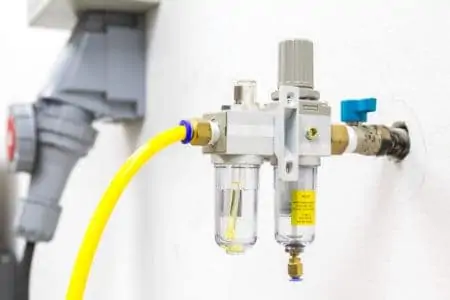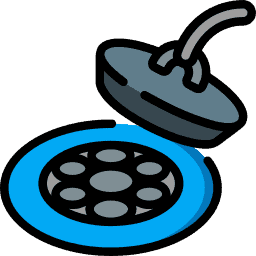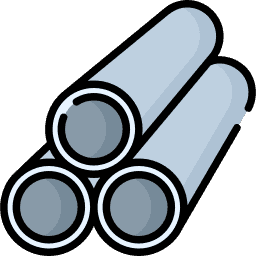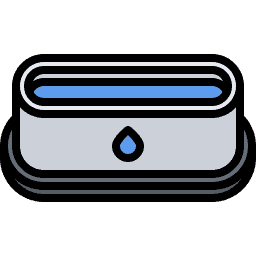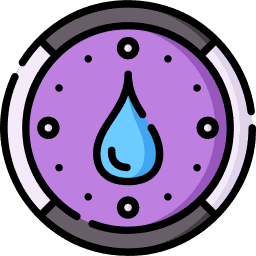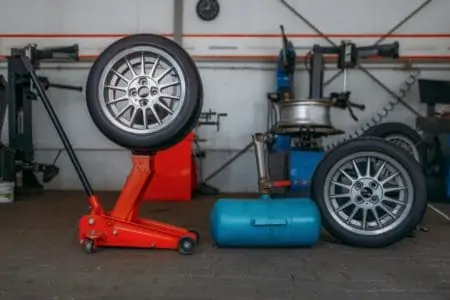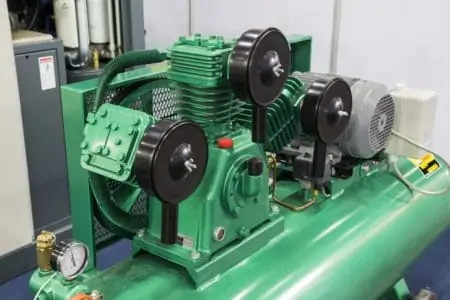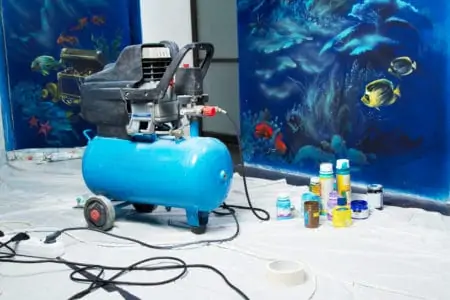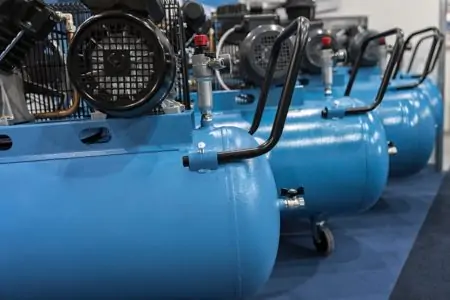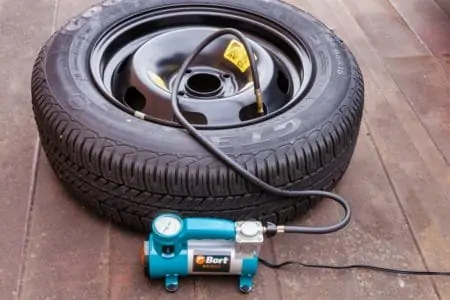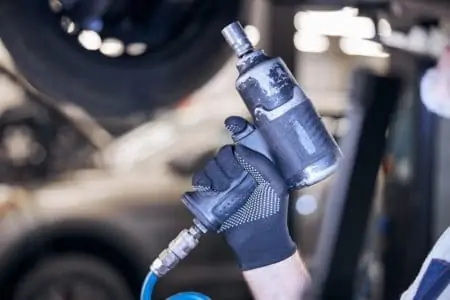Contaminants can get into your air compressor, causing damage to the components and your air tools. Making sure the water that collects in your air tank is as clean as possible is vital to the long working life of your devices.
Here’s our guide to getting the best water separator for your air compressor.
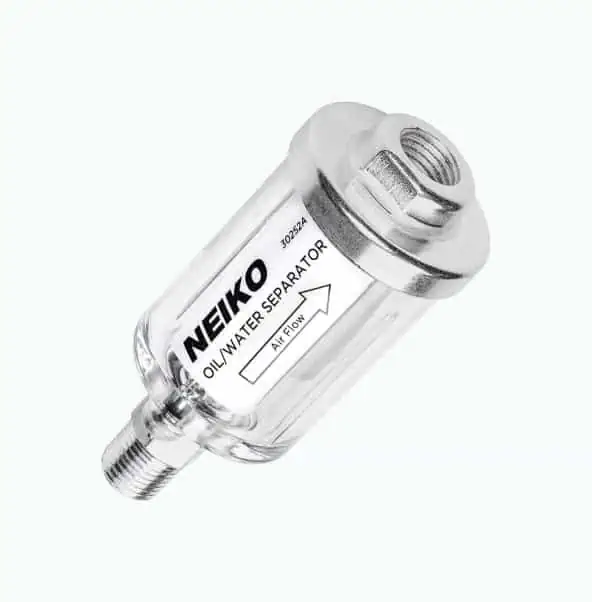
- Quick-release housing
- Aluminum body
- Universal inlet
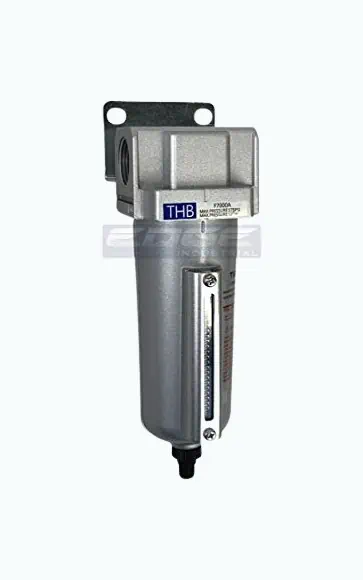
- Maximum of 175 psi
- All-metal housing
- Automatic drain
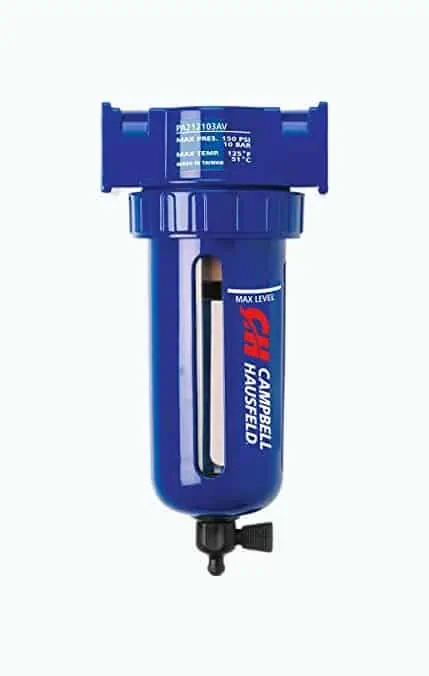
- Quick-release valve
- Traps 99.9% of particles
- 0.375-inch NPT inlet
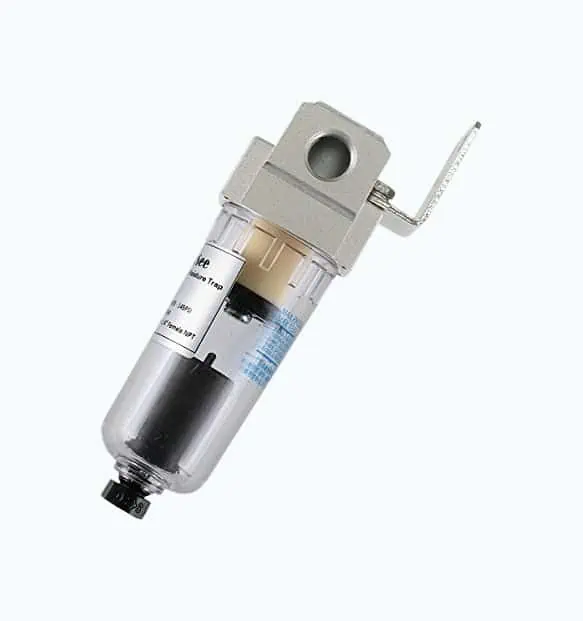
- Auto-drain feature
- Maximum of 145 psi
- 0.25-inch inlet
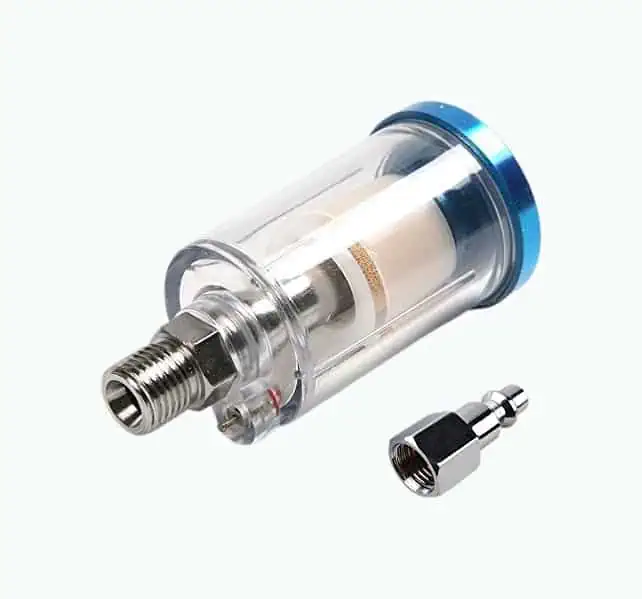
- Attaches directly to the air tool
- Maximum of 90 psi
- Made from zinc alloy
Review Methodology: At Sensible Digs, we prioritize your needs and trust by providing comprehensive and hands-on evaluations of the best water separators for air compressors. Our experienced professionals conduct thorough research, use stringent criteria, and employ rigorous tests to rank and review each product. We analyze factors like performance, design, and user experience, and compare each separator to its competitors. Our assessments and findings are based on first-hand experience and solid data, ensuring that our recommendations are reliable. We explore the key decision-making factors such as durability, cost-effectiveness, and efficiency, providing you with the information you need to make an informed choice. Trust us to help you find the best water separator for your air compressor needs.
- Our Top Picks
- Product Reviews & Ratings
- Product Comparison Chart
- Does My Air Compressor Need a Water Separator?
- How Does a Water Separator for Air Compressors Work?
- How To Choose the Best Air Compressor Water Separator?
- How To Use an Air Compressor Water Separator?
- Water Seperator FAQs
- Preserve Air Tools With a Water Separator
The Best Air Compressor Water Separators of 2024
Here are our top 5 air compressor water seperators.
Neiko 30252A Water and Oil Separator
Best Air Compressor Water & Oil Separator
This Neiko is our pick for the top water separator, and looking at the satisfaction ratings and the sheer number of sales, it’s easy to see why. It has a 0.25-inch NPT universal inlet, which easily connects with spray guns and air tools.
It’s well constructed, with aluminum housing and brass fittings to maximize the lifespan and a clear polycarbonate bowl so you can see when the filter needs changing. Just press the release valve, and all the debris escapes. It also operates on a maximum working pressure of 90 PSI.
The other great thing about this separator is the price. It sells for a lot less than many similar models, and yet it gets great reviews.
For all-round performance, price, and customer satisfaction, this had to be our top pick.
Pros
- Great price.
- Quick-release housing.
- Aluminum body.
- Universal inlet.
Cons
- Reliability issues.
Product Specs
| Weight (ounces) | 3.52 |
| Dimensions (inches) | 6.8 x 5.1 x 2 |
| Max PSI | 90 (Comes in a 150 PSI version) |
| Material | Aluminum |
| Inlet size (inches) | 0.25 |
| Price | $ |
Our Ratings
User Experience
THB Heavy-Duty Water Regulator
Best High-Flow Air Compressor Water Separator
If you want a separator that handles high flow rates, this could be the best choice. It has a maximum working pressure of 175 PSI and an airflow rate of 140 CFM. This device gives you the option to scale up your tools and get some heavy-duty work done.
It keeps dirt, dust, and oil from entering your compressor tank and damaging your air tools, and thanks to the metal bowl and housing, it is robust enough to take whatever punishment you throw at it.
The NPT inlet is 0.375 inches in diameter, but it does come in a larger 0.50-inch size. It even has an automatic drain that kicks in when the bowl gets to half-full. This saves you precious time and keeps you working as you don’t have to stop to empty the debris from the bowl.
Pros
- 0.375-inch inlet.
- 140 CFM.
- Maximum of 175 PSI.
- All-metal housing.
- Automatic drain.
Cons
- Expensive.
Product Specs
| Weight (ounces) | 1.65 pounds |
| Dimensions (inches) | 8.78 x 3.58 x 2.87 |
| Max PSI | 175 |
| Material | Metal |
| Inlet size (inches) | 0.375 |
| Price | $$$$ |
Our Ratings
Personal Perspective
Campbell Hausfeld Quick Release Water Regulator
Best Air Compressor Water Separator With Quick-Release Bowl
Campbell Hausfeld is a respected name in the compressor world, so it stands to reason that they should also produce outstanding water separators. This model has a quick release feature that enables you to remove the dirt and debris faster than other models.
Unlike the Neiko, this separator has a 0.375-inch NPT inlet, so it’s slightly wider. The oil filter traps 99.9 percent of all oil aerosols, and the desiccant system removes water vapor, and the outlet screen stops desiccant particles from entering the compressor.
This model stops particles as small as 5 microns and has an airflow of 57 CFM at 90 PSI. This water separator is more expensive than the Neiko, costing over 3 times as much, but when you look at the level of filtering this model offers, you might overlook the price.
Pros
- Quick-release valve.
- Traps 99.9 percent of particles.
- 0.375-inch NPT inlet.
- Stops particles as small as 5 microns.
Cons
- Expensive.
Product Specs
| Weight (ounces) | 8 |
| Dimensions (inches) | 3 x 3 x 10 |
| Max PSI | 90 |
| Material | Metal |
| Inlet size (inches) | 0.375 |
| Price | $$$ |
Our Ratings
Community Feedback
CrocSee C1.8C.027 0.25-Inch Automatic Drain Water Regulator
Best Air Compressor Water Separator With Auto Drain
Finding a water separator with an automatic drain is actually quite rare. Most models are either manual or semi-automatic. This CrocSee model has a drain system that empties when the compressor is idle and seals again when it is under pressure. You never have to worry about contaminants entering your compressor.
This separator cannot match the THB model for airflow and PSI maximums, but it does have a respectable maximum of 145 PSI and a CFM rate of 26. The NPT inlet measures 0.25 inches, and it has a working temperature of 140 degrees Fahrenheit.
It even comes with a wall bracket to help you mount it. Pricewise, this model is more in keeping with the Neiko separator, costing half that of the Campbell Hausfeld version.
Pros
- Auto-drain feature.
- Maximum of 145 PSI.
- 0.25-inch inlet.
- Great price.
Cons
- Lacks airflow.
Product Specs
| Weight (ounces) | 4.8 |
| Dimensions (inches) | 4.88 x 2.01 x 2.01 |
| Max PSI | 145 |
| Material | Metal |
| Inlet size (inches) | 0.25 |
| Price | $$ |
Our Ratings
First-Hand Impression
Jewboer Water Oil Separator For Spray Gun
Best Air Compressor Water Separator for Painting
When it comes to using a spray paint gun, this Jewboer model is a great choice. It attaches directly to the air port of the spray gun so that you can monitor the separator for dirt and debris. It also allows the vapor to cool as it travels along the air compressor hose and collects in the bowl of the separator.
It has a maximum working pressure of 90 PSI, but with most spray guns, especially HVLP guns, they operate better at a lower PSI. This model stops oil, water, and foriegn objects from finding their way into your air tool.
The inlet and outlet port measure 0.25 inches, and it retails at an incredible price. The downside is while this separator is advertised as NPT, many buyers have complained that it is, in fact, an NPS thread.
Pros
- Great price.
- Attaches directly to the air tool.
- Maximum of 90 PSI.
- Made from zinc alloy.
Cons
- Not NPT threads.
Product Specs
| Weight (ounces) | 3.98 |
| Dimensions (inches) | 4.4 x 1.7 x 2.8 |
| Max PSI | 90 |
| Material | Zinc-alloy |
| Inlet size (inches) | 0.25 |
| Price | $ |
Our Ratings
User Experience
| Product | Best | Weight | Dimensions | Max PSI | Material | Inlet size |
|---|---|---|---|---|---|---|
| Neiko Water and Oil Separator | Water & Oil Separator | 4 oz | 6.8 x 5.1 x 2″ | 90 | Aluminum | 0.25 |
| THB Heavy-Duty Water Regulator | High-Flow | 1.65 lbs | 8.78 x 3.58 x 2.87″ | 175 | Metal | 0.375 |
| Campbell Hausfeld Water Regulator | Quick-Release Bowl | 8 oz | 3 x 3 x 10″ | 90 | Metal | 0.375 |
| CrocSee Automatic Drain Water Regulator | Auto Drain | 4.8 oz | 4.88 x 2.01 x 2.01″ | 145 | Metal | 0.25 |
| Jewboer Water Oil Separator For Spray Gun | Painting | 3.98 oz | 4.4 x 1.7 x 2.8″ | 90 | Zinc-alloy | 0.25 |
Does My Air Compressor Need a Water Separator?
Water separators play a crucial role in protecting your air compressor. Contaminants are harmful to your air tools and can lead to damage and reduced working time. Compressed air contains vapor, which traps in your air tank.
There are variants of what constitutes contamination, but the main ones are:
- Water.
- Water vapor.
- Solid particles.
- Oil.
- Oil vapor.
A water separator reduces the level of contaminants within that moisture, leaving your compressor free to do its job while you can drain the water away using the drainage valve.
How Does a Water Separator for Air Compressors Work?
There are two ways a water separator works to remove contaminants. Both are effective, but what are they?
Centrifugal Separators
This type of separator uses a spinning motion to rotate the air inside the tank. This causes the pollution particles to speed up, which pushes them to the outer edge of the tank towards the separator.
Draining the separator is done either manually or automatically.
Coalescing Separators
Coalescing separators use filters to trap pollutants. Compressed air passes through the inside of the filter, pushing it towards the outside, where it gets siphoned away.
Because the filters clog over time, it is advisable to change them regularly if you want to keep the compressor clean at all times.
How To Choose the Best Air Compressor Water Separator?
There are some basic features you should look for when choosing an air separator. Let’s focus on what matters.
How To Use an Air Compressor Water Separator?
Knowing how to operate a water separator is vital if you want to get the most from it. Here’s a handy guide.
1. Keep a Distance Between the Tank and the Inlet
The air needs to cool before it rushes through the filter. If it’s hot, it could cause the separator to stop working. You should keep a distance of 50 ft between the tank and the inlet.
2. Mount on the Wall
Connect the L-shaped bracket to the filter and then tighten the bolts. Next, take a block of wood to mount the filter and then attach the whole thing to the wall.
3. Connect the Hose
Making sure the port sizes match, connect the hose to the filter inlet.
4. Run the Air Tools
Connect your hose to the air tool and then join the other to the filter. Switch on the power button, and keep an eye on the moisture levels as you work, especially if you have a manual drain system.
Water Seperator FAQs
Preserve Air Tools With a Water Separator
Water separators save you a lot of hassle further down the line because they keep the inside of your air compressor and tools squeaky clean. Imagine all that debris inside your compressor without a water separator. Think of the damage it can do and the cost of buying replacement tools.
When you weigh it up, it’s pretty hard to deny that water separators are cheap and they save you money.
